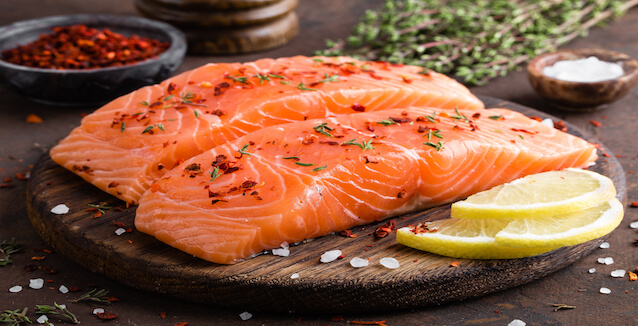
Cooking Basics
How to cook salmon
With its vibrant colour and buttery texture, salmon is a favourite for many fish lovers. It’s packed with omega-3 fatty acids, protein and vitamin D, making it a nutritional powerhouse. Its unique, rich flavour and tender texture make it a must-have in a variety of cuisines.
Whether grilled, baked, pan-fried or poached, this fish always promises a delicious dinner! If you want to improve your salmon-cooking skills but don’t know where to start, we’re here to help!
In this article, we’ll show you everything you need to know about cooking salmon. Our spice blends will ensure you save time and effort, while still enjoying the same great taste!
Choosing the right salmon to cook
Choosing the perfect piece of salmon for your dish is more than just picking any fish from the counter. It involves understanding the type, judging its freshness and recognising the nuances in colour. Here are some points to consider when choosing the right salmon for your dish:
Differences between wild and farmed salmon:
Wild-caught salmon: Hailing mainly from the Pacific Ocean, wild-caught variants like sockeye or king have an intense flavour, firm texture and a vibrant vermilion colour. They are also lower in calories and fat than their farmed counterparts. However, it’s more expensive and less available because of its seasonal nature.
Farmed salmon: Predominantly from Atlantic salmon stock, farmed salmon can be bought in any supermarket. Its flavour is milder and its texture more consistent. The colour of the flesh is often a result of the feed, resulting in the familiar light pink we all associate with salmon.
Signs of freshness:
Always look for salmon with bright, moist flesh. The edges shouldn’t be discoloured. If you’re considering a whole salmon, the eyes should be clear and bright and the skin should have a shiny, silvery sheen.
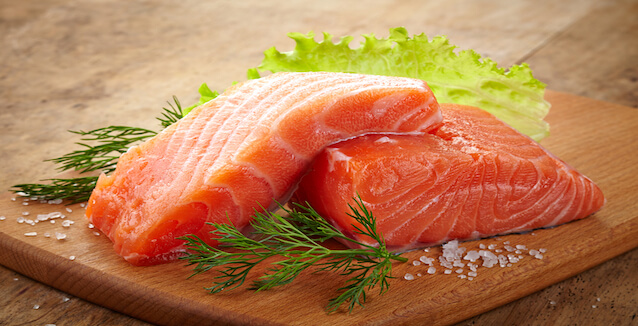

Preparing the salmon for cooking
Preparing your salmon before cooking is just as important as the cooking process itself. Before you start, make sure you follow these steps:
Gently rinse the salmon under cold water to remove any residue or scales from the skin. Be careful not to splash the sink area and taps too much.
Pat the salmon dry on both sides with kitchen paper. This step is particularly important if you’re going to pan-fry or grill your salmon, as moisture can prevent the skin from becoming crispy.
If you’re using a marinade, leave the salmon in it for 15–30 minutes. Remember, salmon doesn’t need to be marinated for a long time because of its delicate texture. Simply mix a few spice blends with olive oil or melted butter for the perfect marinade.
When it comes to the garnish, lemon wedges and fresh herbs are your best bet.
Different cooking methods for salmon
Just as there are many ways to season your salmon, there are also many ways to cook it. Here’s a quick guide to the different techniques and what to look out for.
Pan-fried salmon
To fry your salmon in a pan, you first have to pat it dry with a piece of paper. Heat the pan and add a little oil, so the salmon doesn’t stick. Fry the salmon from all sides so it becomes crispy from the outside. If the salmon fillet has skin, fry it with the skin down first. Just before it’s done, you should add your favourite spices and herbs.
Hot tip:
If you choose to marinate your salmon with a teriyaki sauce, we recommend frying it with the sauce and adding another layer of the sauce towards the end. That way your salmon will take on a nice glaze!
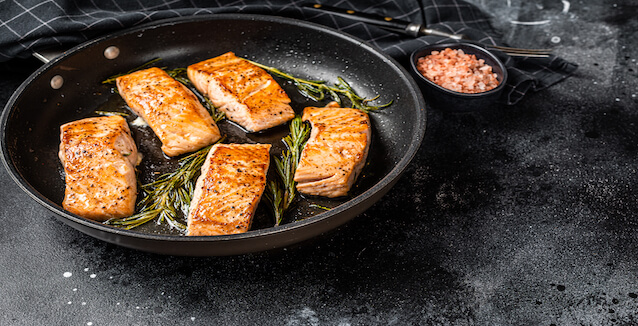

Baked salmon
Baked salmon is a good method if you don’t want to use a lot of oil. Preheat your oven and season your salmon while you wait. Cooking the salmon in an air fryer is also an excellent alternative!
When baking salmon, we recommend traditional seasonings such as lemon, dill and mustard. Adding lemon, an acid, is very important in order to make sure the salmon is tender.
Remember: Wrap your salmon in foil or cover it with a lid so it doesn’t dry out!
Grilled salmon
Make sure the barbecue is really hot before you place your salmon on it, and be sure to oil the grates. Put the salmon with the skin side facing down first and then carefully turn it over after a few minutes. A spicy and smoky seasoning is the perfect way to enhance the smoky aromas from the grill!
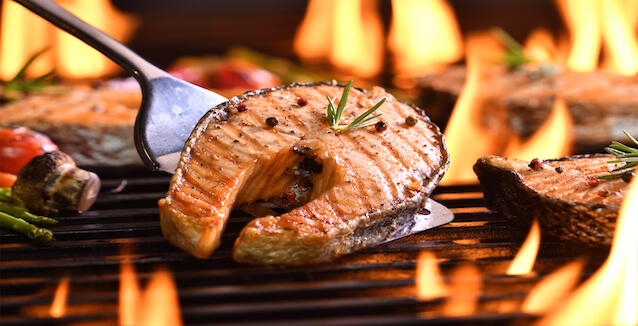

Poached salmon
Poached salmon has a clean, refined flavour, making it perfect for adding any sauces. This cooking method also makes sure that your salmon isn’t dry. Slow cooking in liquid infuses the fish with flavour and makes it very tender.
To poach salmon, you can use:
Court bouillon: A stock made from carrots, onions, celery, herbs and sometimes wine or vinegar.
Milk: Gives a creamy, rich texture.
Broth or stock: Adds depth to the flavour of the salmon.
Wine or citrus juice: Adds acidity and brightness.
Here are the steps you need to follow:
Heat the liquid:
Bring your liquid to a simmer, not a boil. Bubbles should barely break the surface.
Add the salmon:
Gently lower the salmon pieces into the simmering liquid, ensuring they are fully submerged. If not, add enough liquid to cover.
Maintain the temperature:
Keep the liquid at a gentle simmer. Boiling may cause the salmon to fall apart.
Cooking time:
Poach the salmon for 5–10 minutes, depending on the thickness of the cut. The salmon should flake easily with a fork but will still be moist inside.
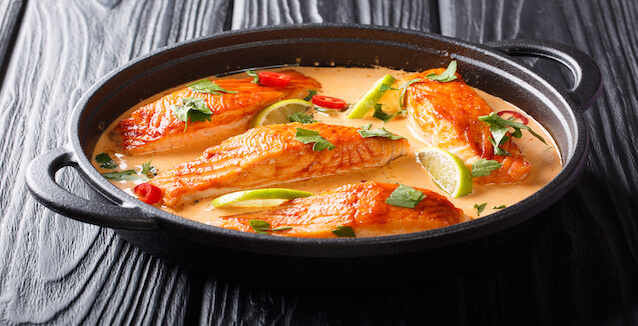

Cooking time and temperature guidelines
The delicate nature of salmon requires attention to cooking time and temperature to get perfect results. Timing will vary depending on the method you choose, the thickness of the fillet and your personal preference for doneness.
Pan-fried salmon:
Heat your pan over a medium heat and fry for 7–10 minutes.
Baked salmon:
Preheat the oven to around 190°C (fan). Cooking time is usually 12–15 minutes.
Grilled salmon:
Heat the barbecue to a medium heat. This will take about 5–7 minutes with a gas barbecue, longer for charcoal.
Poached salmon:
Bring the liquid to a boil and poach for 15–20 minutes, remembering to fully submerge your fillet.
Serve when the salmon is still slightly pink in the middle, allowing the salmon to rest for a few minutes after cooking.
If you’re unsure whether the salmon is done, use a fork to gently pierce the thickest part of the fish. If the flesh begins to flake apart, it is ready.
Best spice blends for salmon
Serving suggestions for salmon
Once your salmon is ready, there are a few simple tricks you can use to enhance it before serving:
A squeeze of lemon over your cooked salmon will instantly brighten its flavour.
For an extra touch of freshness and colour, sprinkle some freshly chopped herbs such as dill, parsley or chives over the top.
Salmon goes beautifully with side dishes such as a fresh salad, roasted vegetables or even buttery mashed potatoes.
Enjoy your perfectly cooked salmon!
Cooking basics with Just Spices
In this article, we’ve taught you how to cook salmon in different ways. Want to know more about seasoning salmon? Check out our article on how to properly season salmon. We’ve also got a salmon recipe collection with all our favourite salmon recipes.
If you want to become a pro in the kitchen, take a look at our cooking basics blog category. You can find all sorts of articles on how to cook different ingredients such as how to cook pasta or how to cook schnitzel.



